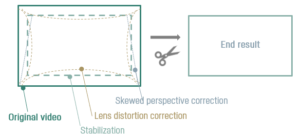No extra cropping for horizon correction

With independent video enhancement features from different providers, each additional feature means additional cropping.
For still images, correcting a skewed horizon after capture is quite straightforward. To do the same for a video – in real time – is much more challenging.
Normally, compensating for a skewed horizon means cropping a lot of the image. Moreover, if you apply several features in sequence, the resulting image could end up way smaller than the original field of view.

Vidhance features uses the same input parameters which results in less cropping.
However, since Vidhance Horizontal Correction is performed in parallel with the other stabilization processing and quality-improving algorithms of the Vidhance platform, no extra cropping is needed outside of the standardized processing.
Efficient and cheap calculations
So how is this powerful, fast, and – in a computational way – cheap feature even possible? Well, one of the secrets to our efficient horizon correction feature is to apply the algorithms based on sensor data instead of based on image calculations. The use of sensor data means using less computational power and thus less battery.
The sensor data approach is also more reliable since sometimes the horizon is difficult for the algorithms to detect in the image, although the tilt may still be annoying to the human eye.
Real-time processing even in preview
The parallel and real-time processing of all the Vidhance features also means that you achieve a “what-you-see-is-what-you-get” result. Is there anything more annoying than setting up your field of view perfectly before the capture and then ending up with a heavily cropped video because of all the applied corrections?
Having the result visible already in preview mode makes the outcome more predictable. While capturing the video the processing is of course also applied in real-time, there is no latency and no time-consuming post-processing.
Customization and ease-in along an S-curve
Of course, there is an upper limit for how much tilt the Vidhance Horizon Correction can – and should – compensate for. After reaching the predefined maximum tilt degree, Vidhance Horizon Correction will ease in along an S-curve and start to follow the camera’s movements smoothly and seamlessly.
The range of tilt is customizable, leaving open the trade-off between the amount of cropping and the level of correction. The desired level of correction may also depend on what type of video you are capturing and the impression that you want to convey.
Power to the user via the GUI
Vidhance SDK for Horizon Correction comes with basic GUI and visualization features to allow for powerful user experience. The GUI provides the user with feedback on the current tilt and whether the camera rotation is beyond the predefined limit of skewed horizon correction.
Increase the DXOMARK score
Let’s admit it, we all want to reach as high on the DXOMARK score as possible.
Correcting skewed horizons and then have a smooth ease-in when the rotation is intentional is obviously something that improves the video quality – both subjectively and objectively. Moreover, adding the Horizon Correction feature to your existing Vidhance platform does not deteriorate either the cropping level or the power consumption.
What’s not to like?



